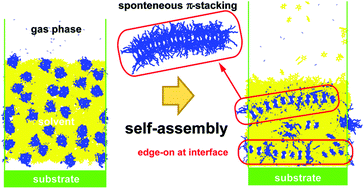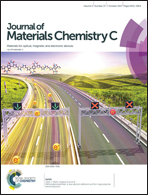Self-assembly of donor–acceptor semiconducting polymers in solution thin films: a molecular dynamics simulation study†
Abstract
The direction of π-stacking in a polymer thin film is crucially important in applications of semiconducting polymers. Two π-stacking configurations, “edge-on” and “face-on”, are most important in applications of semiconducting polymers. However, the molecular-level mechanism of how these configurations are selected is not clear. In this study, we perform molecular dynamics (MD) simulations to study the π-stacking orientations in solution thin films of the donor–acceptor (D–A) semiconducting polymer PNTz4T. Our simulation results showed that the PNTz4T polymers spontaneously π-stacked in an edge-on configuration near the air–PNTz4T/DCB solution interface. Our simulations using a model substrate surface showed that the PNTz4T alignment near the substrate surface was dependent on the substrate interaction strength, i.e., the orientation changed from edge-on to face-on with increasing substrate interaction strength. These results imply that the edge-on and face-on configurations are simply selected by the interaction energetics. We also investigated the effects of blending a fullerene derivative, PC61BM, on the π-stacking orientation of PNTz4T via MD simulations.



 Please wait while we load your content...
Please wait while we load your content...